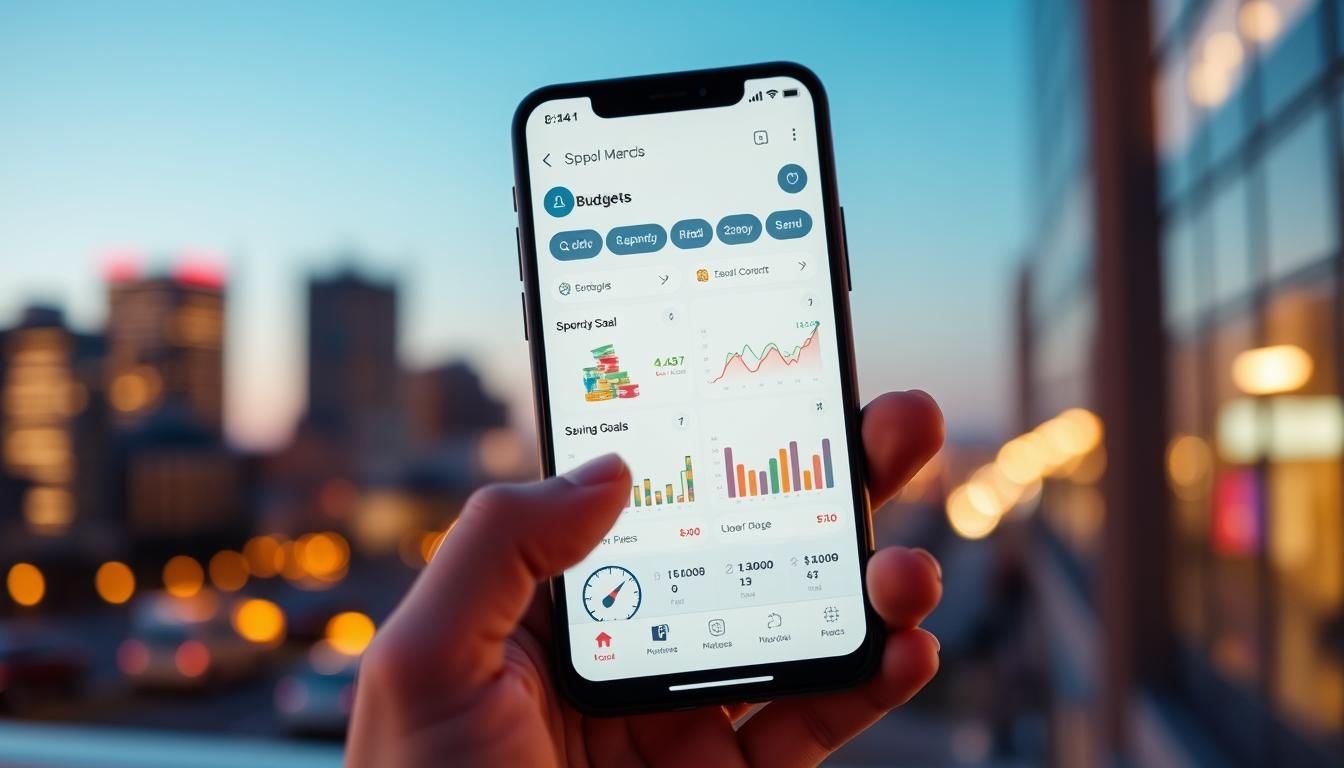Surprising fact: the global smart budgeting apps market is set to jump from USD 1.21 billion in 2024 to USD 6.6 billion by 2034 an 18.4% CAGR that rewrites how people manage money.
This short industry report shows what adoption means for everyday users and teams across the United States. It explains why now is the moment to pick practical finance tools and features that actually speed goal progress.
What to expect: a clear, action-focused guide that covers market figures, drivers, regional trends, security, and a hands-on playbook. We reference leading brands like Mint, YNAB, PocketGuard, and Expensify when showing feature fit.
Whether you manage personal money or run an SME, this report balances strategy and step-by-step setup so users can get results fast. For a deep technical build perspective, see our guide on creating personal finance tools like Mint.
Key Takeaways
- The U.S. leads a growing market; North America held ~36.4% in 2024.
- Expect clearer spending visibility and automated organization from modern tools.
- AI and secure integrations are driving faster feature innovation and user growth.
- This guide serves both beginners and small organizations seeking discipline.
- Security, compliance, and reliable data connections are central to responsible implementation.
Executive summary: the state of digital financial management in the United States
Digital financial management is moving fast in the U.S. More mobile-first users, rising financial literacy, and demand for real-time insights are shifting daily money habits.
Key figures at a glance: the smart market grows from USD 1.21 billion in 2024 to USD 6.6 billion by 2034 (an 18.4% CAGR). North America held a 36.4% share in 2024. The U.S. alone was USD 0.39 billion with a projected 16.8% CAGR.
Why growth is accelerating now
AI and machine learning add personalization. Real-time tracking gives users daily clarity. These shifts raise demand and make finance tools part of routines.
What this means for users and institutions
- Households report better savings and less stress from clear spending insights.
- Institutions can deepen trust via integrations and financial education.
- The wider economy sees new fintech jobs and stronger resilience through inclusion.
What to expect next: the report shows how to pick secure, high-fit tools and which metrics prove impact over time.
Defining the market: budgeting apps, expense trackers, and financial management software
A practical taxonomy makes it easy to match features to users and business size. The market groups include household tools, expense trackers, and full-service management software. Each serves different goals and maturity levels.
 Personal tools focus on simple planning, goal tracking, and alerts. Individuals value ease, automated categorization, and quick insights for saving and optimization.
Personal tools focus on simple planning, goal tracking, and alerts. Individuals value ease, automated categorization, and quick insights for saving and optimization.
SME solutions add multi-user access, cash flow visibility, and invoicing. Small businesses often integrate with payroll and accounting to enforce discipline and speed reporting.
Enterprise suites provide ERP integration, controls, and audit trails. Large organizations need policy workflows, forecasting, and compliance-ready features.
Platform choices matter. Mobile is best for on-the-go checks and notifications. Web interfaces support deeper reporting and team collaboration. Deployment also differs: cloud-first tools scale quickly, while on-premises may suit regulated environments.
Functionally, expense trackers optimize transaction capture and classification. Broader software adds forecasting, tax support, and workflow automation. Integration points include bank feeds, card networks, payroll, and accounting systems setting up deeper coverage later in this report.
- Match simple tools to personal planning needs.
- Choose mid-tier solutions for SME cash flow and invoicing.
- Select enterprise software when ERP and audit controls are required.
Budgeting app adoption: drivers, use cases, and user behavior
A clear snapshot of paydays, bills, and balances turns good intentions into routines.
Why people start: Many seek clarity on spending, steady progress toward savings, and less money-related stress through automated oversight. Mobile-first experiences win because more than 65% of consumers prefer portable expense tracking tools. Small nudges and instant notifications reduce friction and build trust.
Top use cases
- Cash flow tracking: daily inflows and outflows in one feed give instant clarity.
- Bill management: consolidated reminders and payment views cut late fees and anxiety.
- Investment visibility: aggregated portfolios help users see the full financial picture.
User engagement patterns
Freemium funnels convert when free core features and helpful nudges show value. Studies show ~70% retention for new freemium users, with upgrade spikes around tax season and salary days. Similar adoption patterns are seen with subscription-based financial tools across the industry.
AI and aggregation: smarter categorization and unified dashboards create cleaner data and timely alerts. These analytics reduce manual sorting and increase perceived value.
Quick tips: set one clear savings goal in-tool, enable a few key alerts, and do a 20-minute monthly review to keep momentum. For enterprise and banking contexts, learn more about digital onboarding practices at digital adoption in banking.
Market size and growth outlook: present to long-term forecasts
Global demand for smart personal finance tools is reshaping projections for the next decade.
Global view: strong double-digit expansion
The global smart tools market is set to climb from USD 1.21B in 2024 to USD 6.6B by 2034, reflecting an 18.4% CAGR. This outpaces expense trackers, which show a ~10.1% CAGR (20252035). Broader fintech growth sits around 16.5% to 2032, while the financial management software market nears ~$49.9B by 2033.

United States lens: scale, security, and demand
The U.S. market was ~USD 0.39B in 2024 with a 16.8% CAGR. Mature fintech infrastructure and strong security practices boost consumer trust and continued user growth.
Why this matters: AI-driven analytics, tighter integrations, and rising digital financial management literacy drive retention. However, forecasts are sensitive to regulatory shifts, security incidents, and platform changes.
| Segment | 2024 Size | Projected CAGR | Notes |
|---|---|---|---|
| Smart tools | USD 1.21B | 18.4% | Strong AI roadmaps and integrations |
| U.S. market | USD 0.39B | 16.8% | High security baseline and demand |
| Expense trackers | 10.1% | Steady consumer use, niche growth |
Outlook: expect deeper ties with banks, wallets, payroll, and tax systems. That integration will compound value and cement recurring usage for many users.
Regional trends and country insights shaping adoption
Geography matters: infrastructure, culture, and policy dictate which finance solutions scale.
North America leads with mature stacks
North America held a 36.4% market share in 2024 thanks to deep bank partnerships and strong consumer awareness.
Well-developed fintech stacks, easy integrations with banks, and education programs help institutions keep users engaged. Retention is high when tools link to payroll and tax systems.
Europe moves on open banking and privacy
Open banking and GDPR create trust and clear rules for cross-account aggregation.
Countries like the UK, Germany, and France see steady market innovation as providers build secure data flows and region-specific features for local users.
Asia-Pacific: fast mobile growth and rising literacy
APAC shows the fastest growth due to smartphone ubiquity, digital payments, and financial literacy campaigns.
China, India, Japan, and South Korea lead the charge, with select markets projecting ~10.110.2% CAGR (20252035).
Localization matters: language support, local bank APIs, and culturally aware UX improve conversion. Product teams should match privacy norms and saving habits per country to scale effectively.
| Region | Key drivers | Notable markets | Impact on product |
|---|---|---|---|
| North America | Fintech stacks, bank ties, consumer education | USA, Canada | High retention; deep integrations |
| Europe | Open banking, GDPR, trust | UK, Germany, France | Secure aggregation; privacy-first UX |
| AsiaPacific | Mobile banking, payments, literacy | China, India, Japan, South Korea | Rapid user growth; mobile-first design |
Technology and features shaping the next wave of adoption
Modern innovation layers make money management predictive, secure, and easier to use.

AI and machine learning
AI transforms planning from static rules to predictive guidance. Autocategorization and personalized suggestions save time and cut errors.
Chatbots and analytics deliver realtime insights and coaching so users act faster on goals.
Open banking and integrations
Open banking APIs enable multiaccount aggregation and reliable data flows. This integration powers accurate dashboards and timely alerts across credit, bank, and investment accounts.
Security stack
A modern security stack uses biometrics, twofactor options, and strong encryption. Continuous fraud detection, often AIdriven, keeps accounts safer and builds trust.
Blockchain, DeFi, and transparency
Immutable ledgers can add verification and transparency for statements and audits. DeFi links bring new services but also fresh compliance questions for development and legal teams.
User design and gamification
Clear language, inclusive UX, and reward mechanics increase engagement and boost financial literacy. Small wins, streaks, and progress bars make disciplined habits feel rewarding.
- Bottom line: the right mix of features, security, and integration creates usable tools that scale.
Segmentation and pricing models: how users choose and why it matters
How you price and package software often decides which user groups convert and stay. Clear segmentation links deployment, platform, and pricing to real behavior. That lets teams invest where growth and retention are strongest.
Deployment and platforms
Mobile-first offerings on iOS and Android serve quick entries and real-time alerts. Over 65% of consumers prefer mobile for on-the-go tracking and checks.
Web control centers suit SMEs and teams that need centralized reporting and multi-user workflows. Cloud deployments speed rollouts and scale.
User types and needs
Individuals want simple goals and easy features. SMEs need shared access, invoice flows, and exportable data. Enterprises prioritize ERP integrations, compliance, and advanced controls.
Monetization and pricing logic
Freemium lowers barriers and drives trials about 70% retention in early funnels. Premium tiers unlock analytics, forecasting, exports, and priority support. Ad-supported paths subsidize free services for cost-sensitive users.
- Choose platforms that match device habits.
- Estimate true cost by counting integrations, seats, and ongoing support.
- Balance deployment tradeoffs: cloud for speed, on-prem for strict data residency.
Competitive landscape: leading apps, differentiators, and partnerships
The market for personal finance tools is crowded, but a few services consistently lead on features and trust.
Market leaders and quick profiles
Mint (Intuit) wins on broad bank integrations and free aggregation. YNAB focuses on a proactive method that trains users for cash flow discipline. PocketGuard offers sharp, real-time insights. Expensify targets business expense automation, while Wally supports multi-currency users. For a comprehensive comparison, explore the top money manager apps for budgeting and savings.
How top performers differentiate
Analytics depth and clean data pipelines separate leaders. Better pipelines mean fewer misclassified transactions and clearer reports for users with many accounts.
Security posture and transparent privacy policies are major trust signals. Teams that invest in strong encryption and clear terms keep churn low.
Partnerships and practical selection advice
Banks, fintech platforms, and educational institutions extend reach through integrations and co-branded services. Pick a provider based on goal: cashflow discipline, shared household management, or business expense automation.
| Provider | Strength | Use case |
|---|---|---|
| Mint | Integrations | Aggregation |
| YNAB | Methodology | Discipline |
| Expensify | Automation | Business |
Challenges, risks, and regulatory considerations
As the market matures, the biggest obstacles are not features but trust, connections, and clear rules.
Data privacy and compliance demand careful attention in the U.S. Providers must follow CCPA rules and map crossborder flows where data may touch GDPR jurisdictions.
Maintain clear consent records, minimal retention policies, and routine audits to reduce regulatory risk. Institutions should plan breach response playbooks and regular penetration testing.
Integration hurdles and reliability
Connecting to many banks means handling different APIs, uptime variance, and mixed security protocols. These gaps cause sync failures and miscategorized transactions, which harm user trust.
Mitigate with staged rollouts, health checks, and resilient queuing so users see consistent results during outages.
Market saturation and rising expectations
The market is crowded. Many products offer similar features, so differentiation comes from cleaner UX, better insights, and measurable outcomes tied to real spending goals.
Risk management and transparency
Raise the bar with frequent security updates, AIdriven fraud detection, and explainable models. Offer clear permissioning, audit trails, and strong support to retain users.
Adoption playbook: how to get started successfully
A practical playbook turns setup tasks into repeatable habits that stick. Start by clarifying one or two goals: debt reduction or a threemonth emergency fund. Goals guide tool selection and setup steps.
Choosing the right solution: security, features, and fit
Checklist:
- Verify encryption, OAuth 2.0, and 2FA support.
- Confirm multiaccount aggregation, bill reminders, and cash flow forecasting.
- Match core features to your planning and tracking needs before committing.
Implementation steps: connect, categorize, and notify
- Connect accounts via secure APIs and confirm feeds sync.
- Review and adjust category rules; fix misclassifications early.
- Calibrate alerts to avoid fatigueset priority notifications only.
Institutional strategy and continuous improvement
For teams, use usercentric design, AI personalization, and CI/CD for rapid development. Monitor data analytics to iterate features and customer support playbooks. Consider integrating with savings automation features to enhance user value.
“Start with two prioritiesontime bills and an emergency cushionand expand from those wins.”
Measurement that matters
Track: activation, weekly active users, category accuracy, bill ontime rate, savings progress, and churn. Use a 306090 plan: weekly reviews, monthly reconciliations, and quarterly goal updates.
Advice: Begin small, celebrate quick wins, and scale tooling as habits form.
Conclusion
Todays convergence of AI, open banking, and secure infrastructure creates practical paths to better money habits. The market shows clear growth and the timing favors rapid, responsible adoption.
Choose tools that match security and fit, then act with simple goals. Good financial planning and small wins lead to better financial decisions over time.
Start by connecting accounts and setting one or two priorities. Let smart features and measured metrics guide refinements so users see real value quickly.
For households and SMEs alike, disciplined use of these solutions improves cash flow and resilience. Try a short cycle, measure results, and iterate.
Expect continued innovation to raise what these apps can deliver. Watch the market for new integrations and smarter, safer features.
FAQ
What is the best way to get started with a budgeting app?
Begin by clarifying your financial goalsemergency fund, debt payoff, or saving for a home. Link your checking and credit accounts for a full view, then set simple categories and realistic spending limits. Use automatic transaction categorization and enable alerts for low balances or upcoming bills. Review weekly and adjust categories as needed to build a habit.
How do digital financial management tools differ from traditional methods?
Digital tools use real-time data, multi-account aggregation, and analytics to show cash flow and trends instantly. Unlike spreadsheets or manual ledgers, they offer automated categorization, predictive forecasts, and integrations with banks and investment platforms. These features improve decision-making, speed, and transparency.
Are my accounts safe when I connect them to a personal finance platform?
Reputable services use bank-level encryption, two-factor authentication, and read-only access through secure APIs or tokenization. Look for platforms that publish security audits, use biometric login, and comply with CCPA or GDPR where relevant. Limiting permissions and reviewing connected accounts regularly reduces risk.
What features should I prioritize when choosing a financial management tool?
Prioritize multi-account aggregation, automated categorization, spending and savings insights, and customizable alerts. If you invest, pick tools with portfolio tracking and tax-aware reporting. Consider mobile-first design, customer support, and integrations with banks or payroll services for a smooth experience.
How do pricing and monetization models typically work?
Many platforms use a freemium model: basic tracking is free, premium tiers unlock advanced analytics, coaching, or multi-user support. Some offer subscription plans, one-time fees, or ad-supported versions. Choose based on needed features and the value you expect from analytics or coaching services.
Can these tools help me save more or reduce financial stress?
Yes. Clear visibility into recurring expenses, automated saving rules, and goal-tracking increase savings behavior. Behavioral nudges, gamification, and personalized insights from machine learning can reduce anxiety by providing actionable next steps and showing measurable progress.
How do apps handle cash flow and irregular income?
Modern platforms provide cash flow forecasts, buffer recommendations, and customizable rules for irregular paychecks. You can set rolling budgets or income-smoothing features that allocate funds across pay periods to avoid shortfalls and better manage variable earnings.
Will connecting my accounts allow the tool to move money or make transactions?
Most personal finance platforms have read-only connections and cannot move funds. Some services integrate payment or bill-pay features that require explicit permission and additional security checks. Always verify the access level before authorizing any connection.
How do small businesses and freelancers benefit from financial management software?
SMEs and freelancers gain expense tracking, invoice visibility, cash flow forecasts, and tax-ready reporting. Integrations with accounting software like QuickBooks or Xero reduce reconciliation time. Segmented categories and project-level tracking improve pricing and profitability decisions.
What role does AI play in modern financial tools?
AI improves transaction categorization, creates predictive budgets, and delivers personalized coaching. Machine learning finds patterns in spending, suggests saving opportunities, and flags anomalies for fraud detection. These capabilities offer smarter, timely insights without extra manual work.
How do I evaluate a platforms data privacy and compliance posture?
Check published privacy policies, security whitepapers, and compliance claims like SOC 2 or ISO 27001. Confirm how data is stored, whether third parties get access, and how users can delete their data. Platforms that support open banking standards and clear consent flows tend to be more transparent.
What are common barriers to long-term engagement with financial tools?
Drop-off often stems from poor onboarding, inaccurate categorization, overwhelming interfaces, or unclear value in the free tier. Regular check-ins, personalized nudges, and simplified goals can raise retention. Institutions focusing on UX and measurable outcomes see better long-term use.
Can these platforms track investments and retirement accounts accurately?
Many services aggregate investment accounts and provide performance summaries, asset allocation, and tax lot views. For full accuracy, verify holdings against statements and use platforms that support brokerage integrations and real-time pricing feeds.
How do open banking and integrations improve the user experience?
Open banking enables secure, standardized account connections and faster data syncs. Integrations with payroll, billers, and investment firms streamline aggregation and reduce manual entry. This creates a single source of truth and better analytics across finance, savings, and investments.
What should institutions consider when offering financial management tools to customers?
Focus on user-centric design, robust security, and meaningful analytics that drive savings or engagement. Partnering with fintechs for AI features and open banking can accelerate time-to-market. Measure outcomes like retention, savings rates, and product cross-sell to justify investment.
